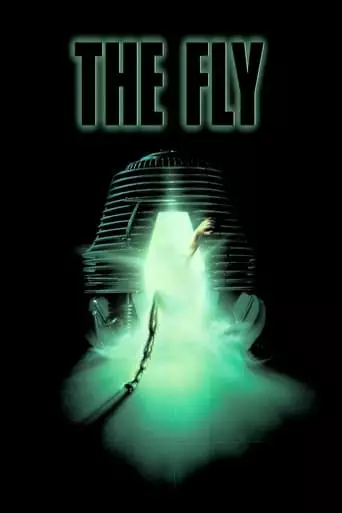When Seth Brundle makes a huge scientific and technological breakthrough in teleportation, he decides to test it on himself. Unbeknownst to him, a common housefly manages to get inside the device and the two become one.
The Fly (1986), directed by David Cronenberg, is a body horror film that explores the terrifying consequences of unchecked scientific ambition, self-experimentation, and isolation. The film is a remake of the 1958 classic but brings a modern and chilling sensibility to the story, particularly exploring themes of transformation, control, and identity.
Plot Overview
The movie follows Seth Brundle (Jeff Goldblum), a brilliant but eccentric scientist who invents a teleportation device. Initially successful, the machine malfunctions when Brundle accidentally teleports himself along with a fly, leading to his gradual and horrific transformation into a human-fly hybrid. As Seth’s body deteriorates and his mind becomes more insect-like, he becomes increasingly monstrous and dangerous, leading to a tragic and intense confrontation with his lover, Veronica (Geena Davis), and the world around him.
Themes
- Transformation and Identity: Seth’s mutation is central to the film’s themes of transformation. His physical metamorphosis reflects a deeper loss of control over his identity. As he becomes less human and more insect, his moral and psychological state deteriorates. The film raises questions about the nature of humanity and identity, and whether physical changes necessarily alter who we are at our core
- Scientific Hubris: Like many mad scientist tales, The Fly critiques the consequences of overreaching science. Seth’s initial excitement over his breakthrough invention becomes a tragic downfall as he disregards safety measures and ethical boundaries in his pursuit of discovery. The film serves as a cautionary tale about the limits of human knowledge and the dangers of pushing technology beyond its moral boundaries
- Isolation and Alienation: Seth’s transformation isolates him from his loved ones and society. As he becomes more grotesque, he retreats further into his laboratory, distancing himself from his humanity. This descent into isolation mirrors the alienation many feel when they are stricken by illness or forced to confront their own mortality
- The Body and the Mind: The physical transformation is also a metaphor for the fear of losing bodily autonomy. Seth’s gradual disintegration emphasizes the horror of losing control over one’s own body. The mind-body connection is central to the film, especially as Seth’s intellect and emotions become overtaken by primal instincts
10 Reasons to Watch The Fly (1986)
- Compelling Performances: Jeff Goldblum’s portrayal of Seth Brundle is both sympathetic and terrifying, a perfect blend of eccentric charm and horror. Geena Davis also shines as Veronica, providing an emotional anchor in the film’s increasingly chaotic narrative
- Intense Body Horror: Cronenberg’s special effects are grotesque but masterfully done. Seth’s transformation is one of the most visceral and disturbing in horror cinema, showcasing Cronenberg’s signature style of body horror
- Thought-Provoking Themes: The film is more than just a monster movie—it explores deep questions about the human condition, including identity, the limits of science, and the fear of disease
- Psychological Depth: Beyond the physical transformation, The Fly delves into Seth’s psyche as he grapples with his own decay, making it a rich character study of a man losing himself
- Cultural Resonance: Released during the AIDS crisis, many viewers saw the film as a metaphor for illness, particularly the stigma and fear surrounding diseases like HIV
- Romantic Tragedy: The relationship between Seth and Veronica adds an emotional layer to the film, providing a heartbreaking love story amidst the horror
- Classic Horror: The Fly is a standout in the body horror genre, offering not only terror but also philosophical reflections on human nature and technology
- Masterful Direction: Cronenberg’s meticulous direction ensures the film is both intellectually stimulating and viscerally horrifying, achieving a balance rarely seen in the genre
- Enduring Impact: The film has had a lasting impact on popular culture, influencing not only other horror films but also broader discussions on biotechnology and human mutation
- Iconic Visuals: From the fly transformation to the grotesque final scenes, the film’s visuals are unforgettable and have cemented The Fly as a landmark in special effects and horror filmmaking
Emotional Impact
After watching The Fly, viewers are likely to feel a mixture of fascination, horror, and sorrow. The physical and psychological degradation of Seth Brundle is both tragic and repulsive, creating an unsettling emotional experience. While the film’s body horror might leave you feeling disturbed, its emotional depth, particularly the tragic romance, might also evoke sympathy for the protagonist despite his monstrous actions. The film’s ending is gut-wrenching and poignant, likely leaving viewers reflective on themes of loss, identity, and the price of ambition.
In conclusion, The Fly (1986) is a remarkable film that blends body horror with existential themes, creating a thought-provoking and unforgettable cinematic experience. It’s a chilling exploration of transformation, isolation, and the consequences of unchecked ambition. The film’s emotional depth, psychological complexity, and gruesome effects ensure that it resonates long after the credits roll.

